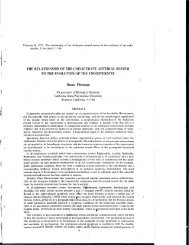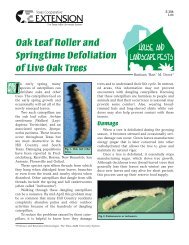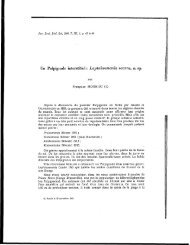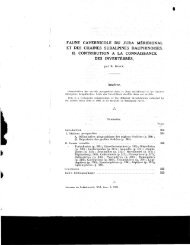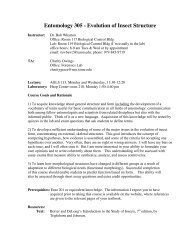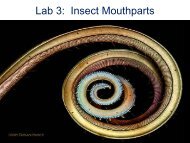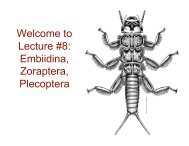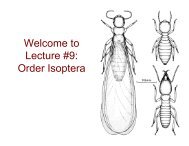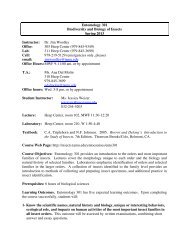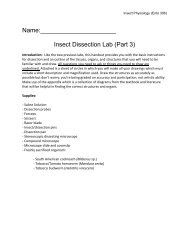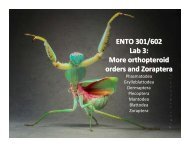Hello everyone, it's thrips day: Lecture #12: Thysanoptera
Hello everyone, it's thrips day: Lecture #12: Thysanoptera
Hello everyone, it's thrips day: Lecture #12: Thysanoptera
Create successful ePaper yourself
Turn your PDF publications into a flip-book with our unique Google optimized e-Paper software.
<strong>Hello</strong> <strong>everyone</strong>, it’s <strong>thrips</strong> <strong>day</strong>:<br />
<strong>Lecture</strong> <strong>#12</strong>: <strong>Thysanoptera</strong>
Zoraptera<br />
Isoptera<br />
Mantodea<br />
Blattodea<br />
Hemiptera<br />
Holometabola<br />
<strong>Thysanoptera</strong><br />
Psocoptera<br />
Phthiraptera<br />
Phylogeny<br />
of<br />
Hexapoda
Order <strong>Thysanoptera</strong> - <strong>thrips</strong><br />
1) mouthparts are adapted for piercing and rasping<br />
(hypognathous or opisthognathous).!<br />
2) the proboscis is a short, conical asymmetrical structure<br />
unique to <strong>thrips</strong>. There are 3 stylets: 1 mandible [the<br />
left one], and the laciniae of the 2 maxillae!<br />
3) Two pairs of narrow wings with reduced venation and<br />
long marginal fringe!<br />
4) metamorphosis intermediate between simple and<br />
complete!
Order <strong>Thysanoptera</strong> - <strong>thrips</strong><br />
• P.S. “Thrips” are like “sheep” or “deer”<br />
• One <strong>thrips</strong> or one sheep<br />
• Many <strong>thrips</strong> or many sheep<br />
• No such thing as a thrip (or a ship)
<strong>Thysanoptera</strong><br />
3) Two pairs of narrow wings with<br />
reduced venation and long<br />
marginal fringe!
<strong>Thysanoptera</strong>
2) !the proboscis is a short, conical<br />
asymmetrical structure unique to<br />
<strong>thrips</strong>. There are 3 stylets: 1<br />
mandible [the left one], and the<br />
laciniae of the 2 maxillae!
Maxillary stylets<br />
Left<br />
mandible<br />
only
Some <strong>thrips</strong> are predators
4) metamorphosis intermediate between<br />
simple and complete!
<strong>Thysanoptera</strong><br />
• Larvae = active, no external wings<br />
– Wings may develop internally<br />
• Propupa = inactive, non-feeding<br />
– Wings develop externally (Terebrantia)<br />
• Pupa = quiescent, sometimes in<br />
cocoon, external wing development
Suborder<br />
Tubulifera<br />
Two Suborders<br />
Suborder<br />
Terebrantia
Terebrantia Tubulifera<br />
1st instar larva larva<br />
2nd instar larva larva<br />
3rd instar propupa propupa<br />
4th instar pupa pupa<br />
5th instar -- pupa<br />
adult adult
<strong>Thysanoptera</strong><br />
• Resembles simple metamorphosis<br />
– More than one instar has external wing<br />
pads<br />
• Resembles complete metamorphosis<br />
– At least some wing development is internal<br />
– Quiescent (pupal) instar (or instars) before<br />
adult stage
2nd =<br />
larva<br />
3rd =<br />
propupa<br />
Tubulifera!<br />
4th =<br />
pupa<br />
5th =<br />
pupa
Suborder<br />
Tubulifera<br />
Two Suborders<br />
Suborder<br />
Terebrantia
Tubulifera!<br />
One family = Phlaeothripidae
Suborder Terebrantia!<br />
Family Thripidae - common <strong>thrips</strong>!



